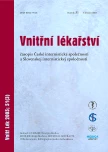Novel findings on iron metabolism
Authors:
M. Šimek
Authors‘ workplace:
Hematologicko-transfuziologické oddelenie Fakultnej nemocnice, Nitra, Slovenská republika, přednosta prim. MUDr. E. Kružliaková
Published in:
Vnitř Lék 2005; 51(3): 345-353
Category:
Reviews
Overview
The article comprehensively summarises novel findings on iron metabolism. Iron resorption by the cell, by the erythrocytes and circulation in the body with further utilisation for the body needs is reviewed step by step. For proper understanding to iron metabolism disorders it is important to understand not only to individual processes in iron processing but also to their regulatory mechanisms that effectively keep iron homeostasis in the body.
Key words:
metabolism – iron – transferrin receptor
Sources
1. Bettany AJE, Eisenstein RS, Munro HN. Mutagenesis of the IRE-BP further defines a role for RNA secondary structure in the regulation of ferritin and TfR expression. J Biol Chem 1992; 267: 16531–16537.
2. Müllner EW, Neupert B, Khn LC. Aspecific mRNA binding factor regulates the iron dependent stability of cytoplasmic transferrin receptor mRNA. Cell 1989; 58: 373–381.
3. Ludwiczek S, Aigner E, Theurl I et al. Cytokine-mediated regulation of iron transport in human monocytic cells. Blood 2003; 101: 4148–4154.
4. Roy CN, Enns CA. Iron homeostasis: new tales from the crypt. Blood 2000; 96: 4020–4027.
5. Riedel HD, Muckenthaler MU, Gehrke SG et al. HFE downregulates iron uptake from transferrin and induces iron-regulatory protein activity in stably transfected cells. Blood 1999; 94: 149–152.
6. Gruenheid S, Cellier M, Vidal S et al. Identification and characterization of a second mouse Nramp gene. Genomics 1995; 25: 514–525.
7. Gunshin H, Mackenzie B, Berger UB. Cloning and characterization of a mammalian proton-coupled metal-iron transporter. Nature 1997; 388: 482–488.
8. Vulpe CD, Kuo YM, Murphy TL. Hephaestin, a ceruloplasmin homologue omplicated in intestinal iron transport, is defective in the sla mouse. Nat Genet 1999; 21: 195–199.
9. Gavin MW, McCarthy DM, Garry PJ. Evidence that iron storesd regulate iron absorption – a setpoint theory. Am J Clin Nutr 1994; 59: 1376–1380.
10. Krause A, Neitz S, Margert HJ et al. LEAP-1, a novel highly disulfide-bonded human peptide, exhibits antimicrobial activity. FEBS Lett 2000; 480: 147–150.
11. Park CH, Valore EV, Waring AJ et al. Hepcidin, a urinary antimicrobial peptide synthesized in the liver. J Biol Chem 2001; 276: 7806–7810.
12. Nicolas G, Bennoun M, Devaux I et al. Lack of hepcidin gene severe tissue iron overload in upstream stimulatory factor 2 (USF2) knockout mice. Proc Natl Acad Sci USA 2001; 98: 8780–8785.
13. Finch C. Regulators of iron balance in humans. Blood 1994; 84: 1697–1702.
14. McKie AT, Marciani P, Rolfs A et al. A novel duodenal iron-regulated transporter, IREG1, implicated in the basolateral transfer of iron to the circulation. Mol Cell 2000; 5: 299–309.
15. Pietrangelo A. Physiology if iron transport and hemochromatosis gene. Am J Physiol 2002; 282: 403–414.
16. Richardson DR, Ponka P. The molecular mechanizms of the metabolizm and transport of iron in normal and neoplastic cells. Biochem Biophys Acta 1997; 1: 1331–1338.
17. Bali PK, Zak O, Aisen P. A new for transferrin receptor in the release of iron from transferrin. Biochemistry 1999; 30: 324–330
18. Garrick LM, Gniecko K, Liu Y et al. Iron distribution in rat reticulocytes after inhibition of heme synthesis with succinylacetone. Blood 1993; 81: 3414–3419.
19. Weiss G, Houston T, Kastner S et al. Regulation of cellular iron metabolizm by erythropoietin: Activation of iron regulatory protein and upregulation of transferrin receptor expression in erythroid cell. Blood 1997; 89: 680–687.
20. Nielsen P, Fischer R, Engelhardt R et al. Diagnosis of hereditary haemochromatosis using non-invasive methods. Transfus Med Hemother 2003; 30: 27–36.
21. Weinstein DA, Roy CN, Fleming MD et al. Inappropriate expression of hepcidin is associated with iron refractory anemia: implications for the anemia of chronic disease. Blood 2002; 100: 3776–3781.
Labels
Diabetology Endocrinology Internal medicineArticle was published in
Internal Medicine

2005 Issue 3
Most read in this issue
- Hyperphosphataemia as an important complication of chronic renal insufficiency and chronic renal failure, part 1 – etiopathogenesis, consequences and diagnostics
- Hyperphosphataemia as an important complication of chronic renal insufficiency and chronic renal failure, part 2 – treatment
- Novel findings on iron metabolism
- Diabetic cardiomyopathy
